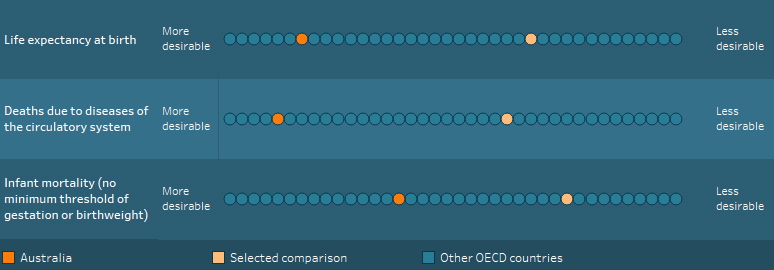Australians generally enjoy good health by world standards. The Australian Institute of Health and Welfare (AIHW) has released a new data visualisation tool comparing Australia’s performance across a range of health-related measures with the data of 36 Organisation for Economic Co-operation and Development (OECD) member countries. Findings are reported online in International health data comparisons, 2020.
Australia performs well on indicators including life expectancy, infant mortality, perceived health, smoking, and road accidents. Australia does not perform as well on measures of obesity and alcohol consumption. We have a relatively high rate of pertussis (whooping cough) infections.
Life expectancy and mortality
Figure 1 shows Australia’s ranking (highlighted in orange) compared with the OECD average (the selected comparator in light orange) and other OECD countries, for three key population health indicators. The indicators are ranked by the desirability of the health outcome. Compared to the OECD average Australians have better health (a more desirable outcome) as indicated by longer life expectancy, fewer than average deaths due to heat attack and stroke, and low rates of infant mortality.
Australia’s life expectancy at birth was 82.8 years—above the OECD average of 80.7 years, and 7th highest among OECD countries, with Japan ranked first at 84.2 years.
Figure 1: population health indicators — life expectancy, causes of death and infant mortality, 2019 (or nearest year)

Source: AIHW (2020) International health data comparisons, 2020.
The most common causes of death across the OECD were diseases of the circulatory system (for example heart attack and stroke) and malignant neoplasms (cancer). The most common disease group for causes of death among Australians was cancer at 184 deaths per 100,000 population (standardised), followed by diseases of the circulatory system.
Australia’s infant mortality rate (with no minimum gestation period or birthweight) was 3.1 deaths per 1,000 live births—below the OECD average of 4.1 deaths per 1,000 live births. However, Aboriginal and Torres Strait Islander Australians experienced an infant mortality rate of 5.8 deaths per 1,000 live births.
Health risks
While the AIHW report only compares Australia’s average health outcomes, we can compare the findings with those of the Australian Bureau of Statistics (ABS) National Aboriginal and Torres Strait Islander Health Survey 2018-19 (NATSIHS). Figure 2 compares findings from the NATSIHS 2018-19 (represented by red triangles) to the Australian average and the OECD average and range as published by AIHW.
Figure 2: daily smoking and obesity rates for Australia, OECD range and average and Aboriginal and Torres Strait Islander Australians, 2019 (or nearest year)

Source: AIHW (2020) International health data comparisons, 2020. ABS (2019) National Aboriginal and Torres Strait Islander Health Survey 2018-19.
Overweight and obesity
Australia ranked sixth highest out of 22 countries with comparable data for the proportion of people aged 15 and over who are overweight or obese (65%). Indigenous Australians are comparable to the United States with 71% of the population overweight or obese.
Australia has the second highest proportion of obese (as distinct from overweight) men (32%), behind the United States (38%).
Smoking
Australia had the sixth lowest proportion of daily smokers among people aged 15 and over (11.2%). Australian men (12.4%) were less likely to smoke than the OECD average of 22.3%. However, 37% of Aboriginal and Torres Strait Islanders smoked every day, a higher proportion than Greece (35%) which was the highest in the OECD.
Of daily smokers, Aboriginal and Torres Strait Islanders at 12.1 cigarettes per day, and all Australians at 12.9 cigarettes per day, smoked fewer cigarettes than the OECD average of 13.3 cigarettes per day.
Health status indicators
Australia’s rate of whooping cough (pertussis) infection was second highest among OECD countries, at 48 cases per 100,000 people, following Switzerland, at 145 cases per 100,000 people.
Australia had the second highest rate of cancer among OECD countries (323 cases per 100,000 people). This relatively high cancer incidence rate may reflect Australia’s high-quality cancer registrations data compared to other OECD countries. Lung cancer rates are below the OECD average.
For the number of days absent from work, Australia (7.3 days) was below the OECD average (9.1 days), per person, per year, due to illness (based on self-reported data).
The OECD Health at a Glance publication notes that answers to the question—‘How is your health generally?’—have been a good predictor of people's future health care needs. Gender, age and social status may affect answers to this question.
Figure 3: perceived health status when asked: How is your health generally? Australia, OECD average and other OECD countries, 2019 (or nearest year)

Source: AIHW (2020) International health data comparisons, 2020.
People (aged 15 and over) living in Canada, were most likely to perceive their health as ‘good/very good’ (89%), with Australia (85%) ranked fourth.
Across all OECD countries, people in the lowest income quintile were less likely to perceive their health as ‘good/very good’ than those in the highest income quintile. In Australia, this ranged from 84% for the lowest and 93% for the highest income quintiles.
In the National Aboriginal and Torres Strait Islander Health Survey, 76% of Aboriginal and Torres Strait Islander Australians rated their health as ‘excellent/very good’ (44.5%) or ‘good’ (31.5%).
Other indicators of how Australia’s health system compares
The report includes a range of performance measures for health delivery in OECD countries, such as:
- health insurance coverage
- money spent per capita, by class of pharmaceutical
- long term aged care -staffing and bed ratios
- health professional’s incomes and
- median waiting time for elective surgery.
The online report includes further details on these and other reported indicators, with links to the OECD data.